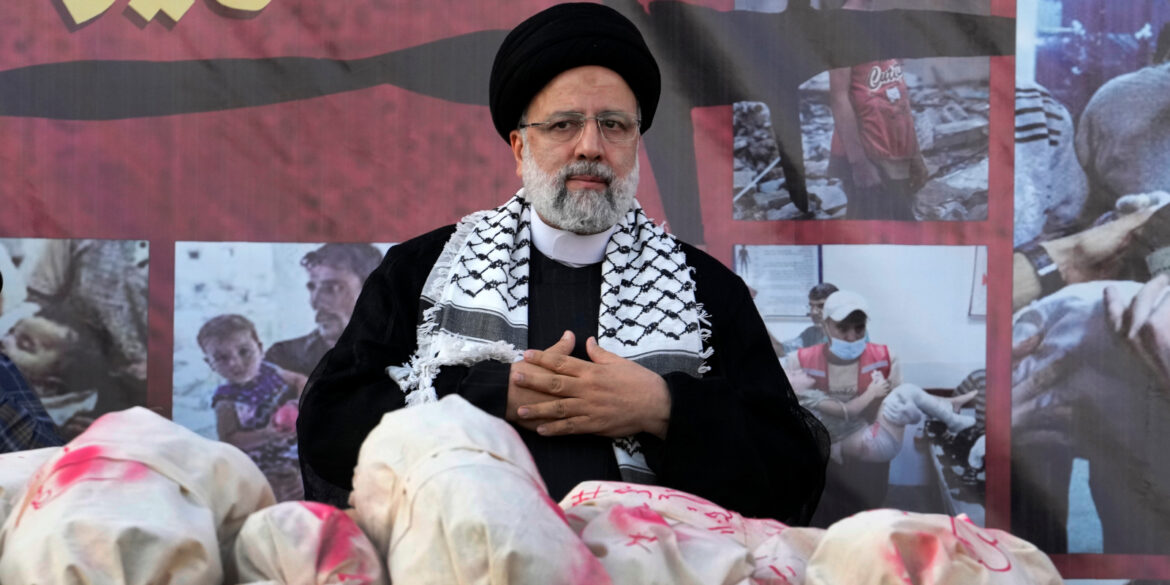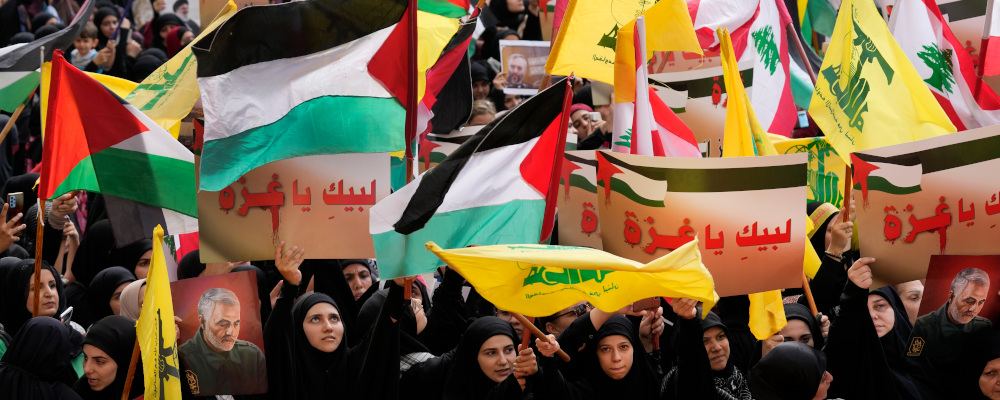Every day there is speculation that the current Israel-Hamas War will widen into a regional war. That is a legitimate concern, but in real terms, the war was never actually narrow. It is the continuation of an already-widened conflict.
Only in the West do we look at war in black-and-white terms, whereas Russia and China look at it as varying shades of black, white, and grey. Russian and China’s view of war is called “political war,” where war continues across a wide spectrum of acts of aggression culminating in full-scale conventional and nuclear war. The lines between war and peace are blurred. Terrorism, assassination, coups, and intimidation using political, economic, and military means are just tools in the toolbox to use in the grey zone and to prepare the ground for larger geopolitical confrontation. That is what we are watching play out in the Middle East.
This is not to say that terrorist groups like Hamas, Palestinian Islamic Jihad (PIJ), and Hezbollah are not fully responsible for the barbarous acts that they perpetrate, or that they are not gross miscalculations. In fact, they are. But a larger geopolitical battle is being waged in the region for power and influence, and Iran, Russia, and China all have had a hand in it at the very least instigating the events of this terrible and sad October.
The events of October 7, 2023, are now all too familiar and horrible to forget. Terrorists of Hamas and PIJ crossed the Gaza frontier into Israel by air, sea, and land and carried out what can only be described as a massacre of the local population in a surprise attack. More than 1,500 terrorists from the two groups were involved in carrying out the raid, and Hamas killed over 1,400 Israelis and foreign nationals, including six Canadians, before crossing back into Gaza with as many as 203 hostages, including two Canadians. The U.S. Heritage Foundation pointed out that proportionally, the attack caused Israeli losses on a level of half that of America’s losses in Vietnam. We have all heard how Hamas and PIJ beheaded toddlers and babies in their bloodthirsty rampage. What many may not heard is that a French journalist who got inside the morgue identifying Israel’s dead saw evidence that Israelis had been tortured and dismembered prior to the deaths.

In carrying out this attack, Hamas and PIJ were provided funds, training, and weapons by Iran and, it now seems, weapons by North Korea. To what degree Hamas and PIJ are controlled or directed by Iran is open to debate, but their attacks coincided with a meeting in Lebanon with Hezbollah and the Iranian Revolutionary Guard Corps officials who both Hamas and Hezbollah claimed assisted in planning the horrific surprise attack. Shortly after the Hamas and PIJ raid, Hezbollah and Palestinian militants in Syria and Lebanon became active and carried out attacks on Israel’s northern border. There are unconfirmed reports that Russia retasked satellites so that it could monitor the Gaza Strip and area around it two weeks prior to the attack. There are further reports that the shadowy Russian mercenary company, the Wagner Group, may have provided training to Hamas and PIJ and that some of the terrorists were trained as far away as Pakistan.
What Israel is up against
In response, Israel cleared and then evacuated its Gaza border towns, killing 1,500 terrorists, mobilized 360,000 reservists in 48 hours, and laid siege to Gaza, while rushing forces to its northern border with Syria and Lebanon. Since that time, the Israeli Defence Force (IDF) has continued to carry out heavy air strikes on Gaza as Hamas and PIJ continue to target Israeli cities with salvos of rockets several times a day. Israel’s military has said well over seven thousand rockets have been fired at Israel since the start of the war, but somewhere around 30 percent malfunction and land back in the Gaza Strip. Israel has carried out limited ground raids into Gaza searching for hostages and killing terrorists in firefights.
The IDF has continued to prepare for a ground offensive that has been postponed by bad weather that could hamper tactical air support for forces likely to be fighting in close-quarter battles on the ground with Hamas and PIJ in what will be, by all accounts, street by street and tunnel by tunnel fighting. Keep in mind, Hamas has a network of an estimated 1,300 tunnels underground in the Gaza Strip stretching 500 kilometres in total. The Israeli’s strategic objective is to degrade the terrorist forces, destroy their command and control, infrastructure, and weapon stores, and free the hostages. While exact numbers are difficult to determine given the fluid situation and the unreliability of numbers provided by Hamas, to date in the Gaza Strip approximately 5,000 Palestinians have been killed and more than 15,000 injured. In the West Bank, 74 people have been killed and 1,300 injured.
Hamas has up to 40,000 estimated fighters and is armed with light infantry, anti-tank and anti-aircraft weapons, drones, and roughly 12,000-15,000 Iranian-supplied rockets and missiles when the latest round of fighting began with their attacks on Israel. It is important to note that in the 2008 Gaza War, Hamas rockets had a maximum range of 40 kilometres, but that had risen to 230 kilometres by the 2021 conflict. Up-to-date figures on PIJ’s strength are difficult to come by, with estimates from ranging from about 1,000 to several thousand, along with light weapons and Iranian-supplied rockets. Hamas and PIJ’s game plan is to fight it out with the IDF while using Gaza’s civilian population—whom it has prevented from evacuating out of the northern areas where fighting is likely—as human shields and to complicate what will be a brutal fight.
At the same time, the IDF also appears to be prepared for a larger possible war with Iran’s proxy Hezbollah in Lebanon, Iran’s other terrorist militia groups in the region, and potentially (but less likely) Syria.1The Syrian Army 4th Armored Division and the 7th Infantry Division have reportedly been placed into a high state readiness opposite the Golan Heights due to the ongoing conflict in Israel, but they have shown no signs of preparation for war. Israel and Hezbollah have exchanged artillery, missile, and mortar fire along the Syrian, Lebanese, and Israeli borders, and Hezbollah attacks and Israel’s response have been increasing. There are increased concerns this could become a larger regional war. Hezbollah has a strength of about 25,000 fighters with another 30,000 fighters in reserve armed with light infantry, anti-armour and anti-aircraft weapons, drones, and likely over 130,000 Iranian-supplied rockets and missiles.
Hezbollah now has possibly thousands of Shahed-131/136 kamikaze drones supplied by their Iranian masters. Additionally, they have some number of 1000-kilometre-range Abu Mahdi anti-ship cruise missiles. Most of Hezbollah’s 130,000 rocket and missile arsenal consists of small and medium-range rockets, including Katyushas, Falaqs, and Khaibar-1s, as well as Fajr-3s and Fajr-5s. In terms of Hezbollah’s longer-range rockets and missiles, they have thousands of Zelzal-2 large-calibre artillery rockets and hundreds of Fateh-class ballistic missiles. These Fateh-class ballistic missiles are the main worry. They have a Circular Error Probable (CEP) of 250 metres and would probably be used to strike key sites such as the Haifa oil refinery and Dimona nuclear facility. In the early 2010s Syria also reportedly handed over a few dozen Scud-D Short Range Ballistic Missiles (SRBMs) to Hezbollah.
Iran’s involvement
At the geopolitical level, Iran has been pushing Hezbollah into a fight with Israel for its own reasons. Tehran has been preaching regional war and screaming for a conflict to eliminate the Jewish state like never before. Like the guest at a party that likes to instigate a fight between two parties and then excuses themselves to go home early or sits back to watch in glee, Iran loves to use its regional Shia Muslim militias to try and push its own influence and agenda for regional hegemony over the top, push the U.S. out of the Middle East and Persian Gulf, and eradicate Israel from the face of the planet. When it has done that, when the U.S. has left and Israel is gone, Tehran can then settle accounts with all the Sunni regimes in the larger Middle East and exact its Persian revenge over the Arab hordes once and for all. Tehran’s dream outcome would be a nightmare for the West, which is why it has backers in Russia and in China who are playing geopolitics and political wars of their own.
The U.S. diplomacy that began under President Donald Trump and continued under President Biden has seen Israel normalize relations with a number of Arab governments. That diplomacy was close to seeing a normalizing of relations between Riyadh and Jerusalem—something that had Tehran seething with rage. China had just brokered a normalization of relations between mortal enemies Iran and Saudi Arabia. Saudi Arabia was also asking for U.S. assistance with a military nuclear program to help the kingdom deter its greater threat Iran, and like the Gulf States, had been sharing intelligence with Israel. This was something that the Islamic Republic had to prevent at all costs.

The obvious move, then, is to instigate, assist, support, and even direct Iran’s terrorist militia allies in Hamas and PIJ to start a war with Israel in the hopes that Israel overreacts and that the Muslim world unites against Israel and the U.S., all the while wrecking the normalization process between Saudi Arabia and the Jewish State. And then if it can widen to include Hezbollah and the rest of Tehran’s proxies, all the better. Using the proxies gives Iran plausible deniability if things go bad and prevents Tehran from getting its hands dirty. Make no mistake, Iran is as guilty in the murder of 1,400 Israelis as Hamas and PIJ are. They just orchestrated the massacre from behind the scenes. If the U.S. then intervened on Israel’s behalf, which was never in doubt, Tehran and its backers and even allies in Russia and China would benefit from draining the U.S. of military resources, opening Washington to attack in Iraq, Syria, and elsewhere, and potentially dividing it from its regional allies—most importantly Egypt, Jordan, Saudi Arabia, and the Gulf States.
Tehran has had a considerable degree of success as Hamas and PIJ are at war with Israel, Hezbollah is chomping at the bit, and U.S. forces have come under attack by Iran’s proxy terrorist militias in Syria and Iraq repeatedly over the past several days. The U.S. shot down several Iranian-made land attack cruise missiles launched by Iranian-backed Houthi militia in Yemen that were destined to strike Israel. U.S. warships are now poised in the Eastern Mediterranean and the Red Sea to provide further air defence against missile attacks from Iran’s regional allies. The U.S. has also sent munitions to Israel, more warplanes to the region, and has troops on stand-by, including 2,000 Marines off Israel’s coast.
International aftershocks
Broader effects are rippling out from the on-the-ground events in Israel and Gaza. There have been riots in several regional capital cities directed at Washington and Jerusalem and we have seen terror attacks in the U.K., Belgium, and France. No one is watching Iran’s nuclear program now that is so close to a nuclear weapon that Tehran’s theocracy can taste it. There is a reason that Russian satellites were up over the Gaza Strip for two weeks prior to the October 7th attack. Russia is now seeing the U.S. redirect military support bound for Ukraine to Israel. China, still trying to gain influence in the Persian Gulf and the greater Middle East, is watching for an opportunity to press its power advantage against Taiwan and the Indo-Pacific. Beijing was brimming with pride at its diplomatic prowess when it normalized relations between Riyadh and Tehran and furious when Saudi Arabia seemed close to normalizing relations with Israel through the efforts of Washington. Now spitting anti-Israel rhetoric, China has sent a “peace envoy” to the area.
What we saw in Hamas and PIJ’s deadly October 7th attack was the tip of the spear. The war is both regional and global on the geostrategic chessboard, and very sadly the West and its allies are playing from behind. Like Ukraine with Russia and Taiwan with China, Israel is bearing the brunt of aggression by an axis of evil not seen since the late 1930s.
For all the Hamas apologists out there, give your head a good shake when you demand a ceasefire for a group of butchers that are holding 200 hostages and firing salvo after salvo of rockets into Israel and know Iran, China, and Russia are laughing at you and could care less for the destruction and death in the Gaza Strip and Israel. It is just all part of doing business in a political war, and, unfortunately, time is on their side.




